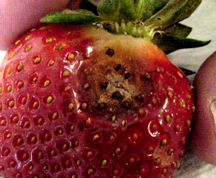Late blight was reported in potato being grown in northern North Carolina on Monday May 29th. This is the first report of Late blight this growing season outside of Florida. No late blight has been reported in the mid-Atlantic region to date. All potato growers are encouraged to scout their fields on a regular basis. The latest Potato|Tomato Disease Forecasting Report can be found here.
Vegetable Disease Update – 5/20/17
- Sunscald injury is being reported on newly transplanted crops with the excess heat this past week.
- Downy mildew has been reported as far north as Northern Florida on multiple cucurbit crops.
- Dickeya dianthicola has been confirmed in Dark Red Norland potato seed in New Jersey. This is the first report of Dickeya in NJ this growing season. Dickeya diathicola has also been reported in potato in VA and FL this year.
- Pectobacterium wasabiae (soft rot or Blackleg) has been confirmed in ‘Red Pontiac’, ‘Kennebec’, and ‘Adirondack Blue’ potato seed in New Jersey this spring.
Vegetable Disease Update – 5/12/17
- Cucurbit downy mildew has been found as far north as central Florida on cucumber, watermelon, summer and winter squash.
- Pythium has been reported in a number of newly transplanted crops.
- With the cooler nights the past few days, cold injury may begin to appear in newly transplanted crops. In pepper, symptoms of cold injury will appear in new growth and look similarly to a mosaic virus infection.
- Best management practices for Dickeya dianthicola in potato have been updated and can be found on the University of Maine’s Extension website located here.
- An article on by Dr. Amy Charkowski (Colorado State University) on managing Dickeya dianthicola in potato on the University of Wisconsin’s Vegetable Crop Update (May 3, 2017) can be found here.
- There will be a Dickaya and Pectobacterium Summit in Bangor, Maine this November. Information can be found here.
Controlling Purple Spot in Asparagus
Like clockwork, purple spot has appeared in some asparagus plantings during mid- to late-April for the past 3 years. Purple spot, caused the soil-borne fungus, Stemphylium vesicarium, can cause problems during cool, wet spring weather (much like we have had over the past week or so). Symptoms, just like its name, include numerous, sunken oval-shaped spots on spears during the harvest season and more importantly on ferns and stalks during the summer months as long as conditions are ideal for its development. Often, purple spot will disappear as quickly as in appears on spears during the spring production season depending on the local weather conditions. As soon as the weather becomes dry and warm (as it appears for the weekend), expect purple spot to disappear. [Read more…]
Controlling Strawberry Fruit Rots – 2017

Anthracnose Fruit Rot of Strawberry
Fruit rots in strawberry can cause significant losses if not recognized early and controlled. The use of good cultural practices such as keeping fields weed-free and promoting good drainage, long crop rotations, and preventative fungicide applications are critical.
Pathogens such as anthracnose, gray mold (Botrytis), and leather rot (Phytophthora) can become systemic problems in strawberry plantings once established. All three fungal diseases are soil-borne and once in fields can be difficult to manage over the lifetime of the planting.
The use of mulch (matted rows) to prevent/reduce soil splashing and keeping fruit from coming into direct contact with the soil surface can be beneficial in organic production systems where conventional fungicides cannot be used. Use of long crop rotations and staying away from areas of the farm with known instances of any of these pathogens is also important. Remember that same species of Colletotrichum that causes fruit rot in pepper and other crops can also infect strawberry.
UMaine to Hold International Potato Disease Summit Nov. 9, 2017
Orono, Maine — Two bacteria threatening the potato industry worldwide will be the focus of a Potato Disease Summit Nov. 9 in Bangor, Maine, convened by the University of Maine.
Plant pathologists, researchers and scientists from The Netherlands, Scotland and five U.S. states will present the latest information on the bacteria — Dickeya and Pectobacterium — that cause blackleg disease, an emerging potato seed problem.
In the past three growing seasons, Dickeya, a bacterial pathogen of potatoes, has caused significant economic losses in seed nonemergence and crop loss nationwide. In addition, an associated pathogen, Pectobacterium, has caused potato crop losses in the field and in storage. The bacteria have caused losses to the potato industry in Europe for an even longer period.
“The University of Maine is responding to this situation by holding an international summit focused on the latest research and what steps are needed to help the potato industry,” says University of Maine President Susan J. Hunter. “As Maine’s only public research university, we are a longstanding partner with the state’s potato industry in addressing its needs, including the growing threat posed by Dickeya and Pectobacterium.”
The Potato Disease Summit, 8 a.m.–5 p.m., Nov. 9 at the Cross Insurance Center, 515 Main St., Bangor, Maine, is designed for scientists, consultants, regulatory officials, and potato seed growers and buyers. It will focus on such topics as current advances in detection and diagnosis of Dickeya; an overview of Pectobacterium in the U.S.; and management of Enterobacteriaceae spread and risk.
The $80 per person fee includes materials, lunch and breaks. Registration deadline is Oct. 2 and is available online: extension.umaine.edu/agriculture/programs/dickeya-and-pectobacterium-summit.
For more information or to request a disability accommodation, contact Steve Johnson, 207.554.4373, stevenj@maine.edu.
